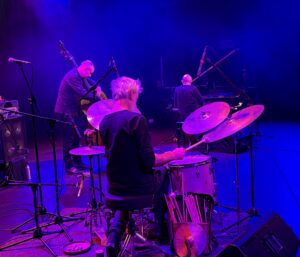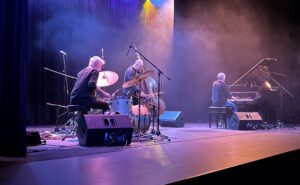Blue Mountains Theatre, February 15
9/10
Thirty-eight years on, the wonder only increases that The Necks’ simple formula results in music without limits. It’s not just a formula for long-form improvisations with evolving cells of repeated information, it’s a formula of musical personalities, and pianist Chris Abrahams, bassist Lloyd Swanton and drummer Tony Buck become ever more distinctive in the options they embrace and those they eschew. They might constitute the only band to ever create a sense of groove without a regular pulse, and the enormity of that achievement is impossible to exaggerate.

Given that every (roughly) 50-minute improvisation is different, and each concert consists of two, to have heard only 40-odd makes generalisations dangerous, but a growing tendency seems discernible for the trio to work in swelling and ebbing waves of sound. Just as beach waves can have cross currents that generate diagonal as well as parallel breaks, so the three players can make their own waves intersect in ways constantly in flux.
These change not only in terms of amplitude, but in terms of occurrence, density, mood and other parameters. Sometimes you seem to be listening to three radio stations at once and sometimes to one instrument played by three people. Then there’s The Necks’ ongoing great mystery, whereby you hear a fourth or even fifth player, because the grand piano, double bass, drums, cymbals, shakers and chimes interact to create ghost sounds that seem to have no source.

Eeriness has always been a Necks hallmark, as has its cousin, portentousness, but perhaps less celebrated has been the band’s capacity for blinding beauty: for cells of melody from the piano worthy of Satie or Debussy, or for equally transfixing lines of arco bass or mallet patterns on the drums. Abrahams began the first improvisation with such demure lyricism as might have been the sound of dew in early morning light, an illusion Buck compounded with a shaker pattern uncannily like cicadas.
Among the many attributes that make The Necks’ music even possible is Buck’s ability to deal in polymetrics, whereby one limb plays a figure that may bear no mathematical relationship to what another limb is doing. Between his four limbs and the others’ hands a labyrinthine complexity of overlaps, convergences and divergences can develop. Or, at the other extreme, is the skeletal simplicity of a piano motif barely shaded by the other instruments.
It’s music that can suggest the dreamy soft-focus of watercolour or the splash of enamel action-painting. Suddenly a hurtling velocity can materialise because of an abrupt three-way convergence, rather than because anyone has radically changed their part. No other band attains such high drama from such simple building blocks, and no other obliges a casual concert-goer to listen with such intensity to the minutiae of technique, because texture and timbre define the music as much as melody, rhythm and harmony.
The Necks: City Recital Hall, February 26.
https://www.cityrecitalhall.com/whats-on/events/switched-on-the-necks/